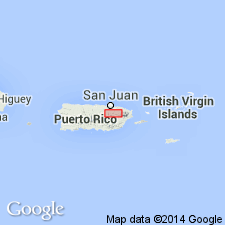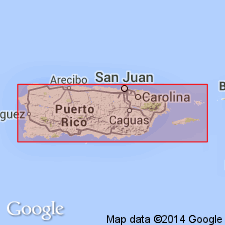
- Usage in publication:
-
- Rio de la Plata Sandstone*
- Modifications:
-
- Revised
- AAPG geologic province:
-
- Caribbean region
Summary:
The Rio de la Plata Formation of Lidiak (1965), here redefined as the Rio de la Plata Sandstone and adopted, consists of thin-bedded to laminated, highly calcareous, volcanic wacke and siltstone interbedded with coarse-grained wacke and volcanic conglomerate. A conglomerate member 190 m thick occurs near the middle of the unit. Unconformably overlies the Santa Olaya Lava; stratigraphically equivalent to the Camarones Sandstone. Thickness is 1,100 m. Age is Late Cretaceous (Coniacian or younger).
Source: GNU records (USGS DDS-6; Reston GNULEX).

- Usage in publication:
-
- Rio de la Plata Sandstone*
- Modifications:
-
- Overview
- AAPG geologic province:
-
- Caribbean region
Summary:
The Rio de la Plata Sandstone occurs in eastern Puerto Rico and consists of volcaniclastic epiclastic sandstone and siltstone interbedded with conglomerate, and locally, andesitic lava flows. Maximum estimated thickness is 1000 meters. The Rio de la Plata is of Late(?) Cretaceous age.
Source: GNU records (USGS DDS-6; Reston GNULEX).
For more information, please contact Nancy Stamm, Geologic Names Committee Secretary.
Asterisk (*) indicates published by U.S. Geological Survey authors.
"No current usage" (†) implies that a name has been abandoned or has fallen into disuse. Former usage and, if known, replacement name given in parentheses ( ).
Slash (/) indicates name conflicts with nomenclatural guidelines (CSN, 1933; ACSN, 1961, 1970; NACSN, 1983, 2005, 2021). May be explained within brackets ([ ]).

